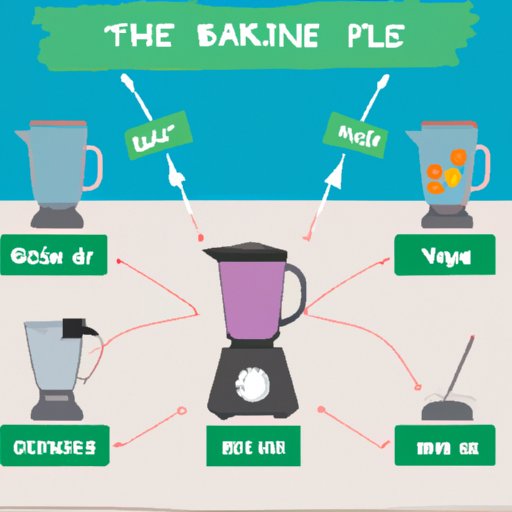Introduction
A blender is a kitchen appliance used to mix, purée, or emulsify food and other substances. It typically consists of a container with a rotating blade at the bottom that is powered by an electric motor. The term “blender” was first used in 1922 and has since become a staple in most kitchens around the world.

A Historical Look at the Invention of the Blender
The invention of the blender can be traced back to Stephen J. Poplawski’s patent for a “drinking glass with rotary blade in bottom.” He filed the patent in 1922 and the first blender was produced in the same year. Early blenders were made of metal and had a two-speed motor. They were designed to be used with a drinking glass, which served as both a container and a mixing vessel.
Poplawski, who worked as a mechanic and refrigerator repairman, created the blender as a way to make milkshakes faster. His invention revolutionized the food industry, making it easier to create blended drinks such as smoothies and milkshakes. Poplawski sold the rights to his invention to Fred Osius, who then went on to found the Hamilton Beach Company. Hamilton Beach continues to sell blenders today.

The Evolution of the Blender from its Inception to Present Day
Since its invention, the blender has undergone several technological advances. In 1936, Fred Waring introduced the Waring Blendor, a more powerful version of Poplawski’s original blender. This blender was capable of blending larger quantities of food and featured a variable speed motor. It was also the first blender to feature a glass jar, which allowed users to blend directly into the container.
In 1946, the Osterizer blender was released, which featured a one-piece plastic housing and a switch to control the speed. This was followed by the introduction of the Vitamix blender in 1949, which featured a high-powered motor and stainless steel blades. This model was the first to include a tamper, which allowed users to push ingredients down while blending.
In 1973, Cuisinart released the first food processor, a device that could chop, slice, and puree food. This device was more powerful than a blender, but less versatile. Since then, blenders have been improved upon and now come in a variety of shapes and sizes, ranging from personal blenders to commercial-grade models.
How the Blender Changed the Way We Prepare Food
The invention of the blender changed the way people prepare food. Before the invention of the blender, food was chopped, diced, and blended by hand. This was a time-consuming process and often resulted in unevenly blended foods. With the invention of the blender, this process became much faster and easier. Blenders are now used to make everything from soups to smoothies.
Since its invention, the blender has seen many improvements in its design and technology. Modern blenders are now equipped with multiple speeds and settings, allowing users to customize their blending experience. They are also capable of blending a variety of foods and liquids, including fruits, vegetables, nuts, ice, and even hot liquids.
Conclusion
The blender has come a long way since its invention in 1922. From its early days as a simple device used to make milkshakes to its modern-day use in food preparation, the blender has revolutionized the way we prepare food. Thanks to technological advancements, blenders are now available in a variety of shapes, sizes, and power levels. Whether you’re looking for a basic blender or a high-powered commercial model, there’s sure to be one that fits your needs.
The invention of the blender has had a major impact on the food industry. It has made it easier and faster to prepare a variety of foods and beverages. From smoothies to soups, the blender has changed the way we think about food preparation.
(Note: Is this article not meeting your expectations? Do you have knowledge or insights to share? Unlock new opportunities and expand your reach by joining our authors team. Click Registration to join us and share your expertise with our readers.)
